#hatice sultan daughter of ahmed iii
Note
Sorry to bother you in this account, I would have a question about Ümmügülsüm Sultan, the possible daughter of Ahmed I. The relazione of Angelo Alessandri from 1637, Page 649 says: "Ha il Gran Signore di congionti per sangue quatro sorelle ancora, ma fuori di seraglio, essendo tutte maritate in visiri." And since I am not really speaking italian, I am not sure if "per sangue quatro sorelle" means full-sister or just a way to say sister (and so can mean half sister too). One of my followers - who says he speaks italian - says it means full-sister and confirms that beside Ayse, Fatma and Hanzade there was another full-sister of Murad IV.
I mean while I have my doubts, Alderson also lists one Ümmügülsüm (wife of Halil Pasha) based on harem registers, who had the same amount of salary in 1639 as Ayse, Fatma and Hanzade, the daughters of Kösem (and some other women - possible daughters of Murad III had the same amount, while Atike and one Hatice possibly daughters of Ahmed I had less salary). Also, there is the known other register that you also mentioned on ottomanladies page, based on Tezcan: “A privy purse register from 1622 gives the names of five unmarried princesses, who may be daughters of Ahmed, Osman II, and even Mehmed III: Umm-i Külsum, Hanzade, Halime, Fatma, and Akile.”
The fact that there was one Ümmügülsüm in 1622 who was still unmarried, and then in 1639 she had the same amount of stipend as Ayse, Fatma, Hanzade and the relazione mentioning that 4 (full)sister thing, maybe suggests that Kösem and Ahmed MAY had another daughter together, Ümmügülsüm? What do you think?
Hello! I guess my askbox on ottomanladies is still closed.
So, your follower is right; what Angelo Alessandri says in his relazione is that Murad IV has four full-blooded sisters who all live outside the palace because they are married. When I read this part, I simply assumed that the fourth princess was Gevherhan but we don’t have any information about her after Recep Pasha’s death in 1632. Then, I assumed he was wrong because it wouldn’t be the first time a European ambassador mistook half-siblings for full-blooded siblings.
About Ümmügülsüm, I have always assumed he was a daughter of Mehmed III’s or Murad III’s. I have never paid attention to her, as I’m sure you know from my posts on ottomanladies.
But you made me curious so I spent some time looking into this.
First, I think you meant Dumas when you mentioned that list based on harem registers because I have found it in Les Perles de Nacre du Sultanate. Alderson doesn’t list an Ümmügülsüm Sultan among Ahmed I’s daughters (unless I somehow missed it).

Secondly, I think there is a problem with this source: on page 62, the register is from February 1649 to February 1650. In Annex A, though, (page 461), she says that the same register is dated February 1639. So what is the truth? February 1639, because the register keeps saying “Şevval 1048”, and that’s February-March 1639 (you can google it). The mistake on page 62 is… weird, though.
Moreover, the list above is somewhat different from the transliteration she put in Annexe A. For example, on page 463 she says that the register says “Hümaşah Sultan merhum Nakkaş Hasan Pasha”, but on the list she put on page 62, the same Hümaşah Sultan is married to one Hüseyin Pasha. I don’t understand why she changed the source without addressing it— or is it just a typing mistake? I hope it is because I think Hümaşah Sultan was truly married to Nakkaş Hasan Pasha: Nakkaş Hasan Pasha was identified as married to one of Ahmed I’s aunts by the Baron de Selignac, and a letter dated 6 October 1642 by a Ragusian diplomat lists among Ibrahim’s aunts one “Humascie sultana moglie di Hasan Pascia [Hümaşah sultan wife of Hasan Pasha]”. In another letter, this one dated 7 July 1648, Hümaşah is identified as “moglie di Nachasc Hasanpascia Humasce sultan vedova [Hümaşah sultan, widow of Nakkaş Hasan Pasha]”.
If Dumas voluntarily changed Hasan Pasha into Hüseyin Pasha then I don’t know why she did it because contemporary evidence suggests that this princess called Hümaşah was Ahmed I’s aunt and therefore Ibrahim’s great-aunt (I won’t fault the Ragusian diplomat for not stating the difference because it wasn’t done often at the time), and was married to Nakkaş Hasan Pasha, who is called “merhum” in the harem register because he was deceased at the time.
Similarly, on page 462, it is listed one “Kameri Sultan merhum Sofi Bayram Pasha”, but on the list on page 62, she is called Fahri. Again, what prompted Dumas to change the wife’s name? Is it because Öztuna says that Fahri/Fahriye Sultan (daughter of Murad III) was married to Sofu Bayram Pasha? Then again, why was she called Kameri in the register? Is it a mistake from the clerk or did she have multiple names? Or did Dumas transliterate her name wrong? Or did she change the princess’ name into Fahri because that’s what Öztuna says? Interestingly, in the family trees in Annex B, she’s called Fahri again. The same Ragusian diplomat above also lists the wife of Bayram Pasha: “Vanni sultana moglie di Soffi Bariam Pascia”; unfortunately I cannot say what Vanni should be because it doesn’t sound like Kameri at all. It could sound like Fahri but… it’s a stretch.
Beyhan Sultan, Safiye Sultan, and Mihrimah Sultan are widows too but it’s difficult to identify them because their husbands are one “Mustafa Pasha”, one “Mehmed Pasha”, and a “Mehmed Pasha from Kefe”. I tried to google this Mehmed Pasha from Kefe and everyone says he was married to Mihrimah Sultan, daughter of Murad III. The problem is the sources of this claim (on those websites) do not say this. The Ragusian letter talks about a Beyhan Sultan married to a “Mustai Pascia” which could be Mustafa Pasha, but this is all I have to say.
I also would like to highlight that the princesses listed in the Ragusian letter are those who received gifts from the Ragusian diplomat so there could have been more, especially aunts.
As for “Atike Sultan Kenan Pasha” (who receives 9,900 aspers per month): she seems to be Ahmed I’s daughter Atike (also confirmed by the Ragusian letter, who lists her among Ibrahim's sister).
Now, about “Ümmügülsüm Sultan Halil Pasha” (who receives 12,900 aspers per month): I still personally maintain that she was an aunt and not a sister. I could not identify her, nor her husband Halil Pasha, but we have to keep in mind that we don’t have all the names of Mehmed III’s daughters. In the Ragusian letter dated 1648, there’s one “moglie di Hersechli Ahmet Pascia Iumi sultan [wife of Hersekli (? it could mean that he comes from Herzegovina) Ahmed Pasha, Iumi Sultan” (Iumi kind of sounds like Ümmi). It’s basically ten years later Dumas' list so she could have changed husband in the meantime but unfortunately, I couldn’t identify “Hersechli Ahmet Pascia”— if someone else has information about him, please do not hesitate to share (with sources, please).
I’m sorry this was so long and unhelpful, I was carried away :(((
EDIT: I have found the Ragusian letters in V. Miović - Per favore della Soltana: Powerful Ottoman Women and Ragusan Diplomats
30 notes
·
View notes
Text
kehribar-sultan: Well thakns four your appreciation, yeah, I really tried hard......But, first I would like to say some words about your comment: 1) I would like to get your acceptance and recognition of possibility that Safiye had all of these four daughters. I would stress out that ambassadors only talked about children of the Topkapi Palace who were notable in political life (case with Murad IV’s four full sisters). I do not agree with you, Ahmed Pasha (Mirahur in 1604) was named governor of Rumelia two times; firstly in 1614 and secondly in 1614. And he wasn’t Aga of the jannisaries. The Pasha you’ve mentioned is someone else. Beside, I found in Dumas’s 2013 book that Mihrimah was same as Mihriban (page 82, note 171). Anyway, she died in early 1610s I quess, and her husband remarried to her half-sister Fahri Sultan in September 1613. Anyway, I suggest that Mihrimah was the eldest, as I proved in citations that Mehmed had a two years older sister than him. Also, I (most strongly) suggest that Hümaşah was Safiye’s daughter, even the youngest, as her husband Hasan Pasha was placed in Divan of Ahmed I, and he referred to her as halem. 2) I didn’t get your comment about suggested (officially unknown) sons-in-law of Murad III, such as Boyali Mehmed Pasha, Siyavush Pasha (failed) and Serdar Ferhad Pasha. I mean, all that marriage negotiations in early 1590s prove that Safiye had more than two daughters. 3) I would suggest that Murad III’s daughters Saime and Fahri were his longest-living daughters, who died in late reign of Mehmed IV (Hümaşah, Beyhan and Hatice died in early reign of Mehmed IV). Anyway, I need to stress out that Fahri’s full name was Fahrihan (source: https://www.isam.org.tr/uploads/6595588ee2276.pdf - page 494 ; also there is Saime too – page 138) 4) I have suspitions that Murad III had one more daughter named Asüde Sultan, but I won’t claim it until I am sure it was his daughter.
I’m sorry if my answers are lacking but it’s just a lot of information to process fast and sometimes I get lost in the labyrinth of Ottoman princesses.
I never said Safiye couldn’t have been their mother. I said that since both Mihrimah and Hümaşah were important people in Murad III’s life, if he ever wanted to honour them he would have done it with his eldest daughters, hence Safiye’s.
I do not agree with you, Ahmed Pasha (Mirahur in 1604) was named governor of Rumelia two times; firstly in 1614 and secondly in 1614. And he wasn’t Aga of the jannisaries. The Pasha you’ve mentioned is someone else
Oh sorry, I copied my notes into the ask. I couldn’t understand what you were talking about until i saw my note in brackets lol. I thought it was him because Öztuna says that Mirahur Ahmed Pasha was, among other things, Janissaries commander and then governor of Rumelia:
=Dâmâd Mîrâhûr Ahmed Paşa (ölm.Ist.1618), izd.21.2.1613, izd.müd.5 yıl. Enderun, çukadâr 1612, hâsodabaşı, mîrâhûr 1613, yeniçeri ağacı 10.1613, vezâret'le Rumeli beyl.2.1614, Şâm 1617-8, mâzûl
I think I’m starting to see why you say that Mihrimah was Safiye’s eldest daughter. It took me a long time (bc i’m stupid) but I’m starting to see the light lol. If Matteo Zane is correct, and this princess was 26 years old in 1592 then there was definitely another daughter of Safiye who, for some reason, was unmarried at the time. If Mihrimah is Murad III’s eldest child then he definitely wanted to honour his beloved aunt (whom he honoured again when she died, burying her next to Süleyman).
I do agree that Hümaşah seems to be the youngest daughter of Safiye.
So, basically, Safiye’s children could be:
A princess (Mihrimah) born in 1564 circa
Mehmed III, born in May 1566
Süleyman, born in 1568-69 (the Venetians say he was two years younger than Mehmed) (he must have died before 1576, when another Süleyman was born)
Ayşe, born in 1569-70
Mahmud, born in July 1572
Fatma, born in 1574
Süleyman, born in December 1576 (and died in 1577)
Selim, born in December 1578
Hümaşah, born in 1580 (?) (though Sakaoğlu says she was born in Manisa)
Öztuna says that a Şehzade Mustafa was born in “1578?” and a Şehzade Osman was born in “1573” in Manisa. Osman was the eldest after Mehmed and died in 1587. Mustafa was executed by Mehmed III in 1595 and was the prince Canfeda had tried to save before being dismissed. Unfortunately Pedani didn’t source this claim, I would have loved to know more about this. These two princes though do not figure in “A COMPARISON OF SEYYID LOKMAN’S RECORDS OF THE BIRTH, DEATH AND WEDDING DATES OF MEMBERS OF OTTOMAN DYNASTY (1566-1595) WITH THE RECORDS IN OTTOMAN CHRONICLES”, so I don’t know. On the other hand, Karaçelebizâde says that the eldest prince executed by Mehmed III was born in 1585… which would make more sense.
Considering that Safiye was sent away to the Old Palace in 1583 and that the Venetian ambassador already reported that she could not have any more children (”seeing that she got ugly and could no longer have children”, dispatch dated 18 September 1583), I’d say that Hümaşah was the latest child she had (or maybe she had a miscarriage/difficult birth afterwards which sealed her condition). Selaniki, on the other hand, says that a 2yo princess died on 29 July 1585… maybe she was Safiye’s last child?
I didn’t get your comment about suggested (officially unknown) sons-in-law of Murad III, such as Boyali Mehmed Pasha, Siyavush Pasha (failed) and Serdar Ferhad Pasha. I mean, all that marriage negotiations in early 1590s prove that Safiye had more than two daughters.
Sorry about that!! So, I didn’t say anything because I thought that what you said made perfectly sense; I had nothing to add. I googled Ferhad Pasha and Wikipedia said that he tried to escape execution by appealing to Safiye. Unfortunately there is no source but it would make sense if he was her son-in-law. Where did you find that Nişancı Mehmed Pasha was governor of Rumelia in 1591? I swear I can’t find it anywhere.
I would suggest that Murad III’s daughters Saime and Fahri were his longest-living daughters, who died in late reign of Mehmed IV (Hümaşah, Beyhan and Hatice died in early reign of Mehmed IV). Anyway, I need to stress out that Fahri’s full name was Fahrihan
Saime stops being mentioned by Ragusian diplomats after 9 August 1670, while Farhi or Fahrihan (which I really like) is mentioned until 9 May 1679 as “Pahari” (unless it’s someone else but that’s the last time someone with a similar name was mentioned).
I’m going to read about Asüde Sultan soon, I’ve seen your message in my inbox :D
8 notes
·
View notes
Text
Portrait of Emetullah Rabia Gülnüş / Emetullah Rabia Gülnüş portréja
Origin and youth
Emetullah Rabia Gülnüş was a woman of Greek descent who was certainly captured during the Venetian-Ottoman War. The grimace of fate is that the outbreak of the war was attributable to Mehmed IV, who later became Emetullah's sweetheart. In the summer of 1645, Ibrahim I declared war on Venice and sent a large Turkish army to Crete. The immediate cause of the war was that Maltese pirates captured an Ottoman ship carrying several influential people. Among them was the wet-nurse of Mehmed IV and her own son, whom Sultan Ibrahim I loved very much. So much that the he cared more with the wet-nurse's son than he did with his own child, Mehmed. The war lasted for decades, until 1669, so it is not possible to determine exactly when Emetullah was captured.
Emetullah was a gift from a certain Deli Hüseyn Pasha, who took the Cretan slaves he had captured to the Sultan’s palace and recommended the bests to the sultan’s harem. Deli Hüseyn Pasha died in 1659, so Emetullah definitely joined the harem before that time. This, unfortunately, does not help us, for considering that Emetullah was already a favorite of the Sultan in 1660 and this had to be preceded by several years of education, so most likely she was captured before 1654. Many give the year 1645 as captivity, however, this is almost ruled out. In general, children under the age of 5 were not caught, because they caused more trouble than benefit, and were more likely to die during the long and tumultuous journey. Assuming that Emetullah was roughly the same old — or younger — than Mehmed IV (born in 1642), she could have been captured in 1648 at the earliest.
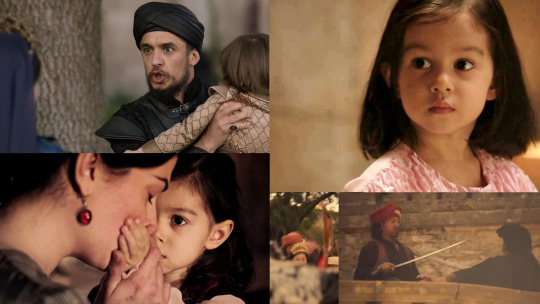
The consort
Emetullah Rabia Gülnüş matured into a beautiful young woman, making her perfectly suited to entertain the sultan. Emetullah is one of the few sultanas whose appearance is known in considerable detail. One of the ambassadors had the opportunity to see one of Emetullah's clothes and belts, on the basis of which he thought the Sultana was a taller-than-average but graceful. The same ambassador heard from his informant that the Sultana had fine skin and blue eyes. Other descriptions said she had black curly hair. Towards the end of her life, Emetullah was reportedly more plump than slender.
It is not known exactly when Mehmed started receiving concubines and when Emetullah became his favorite. Mehmed's first child, a girl, was born in 1660. According to circumstantial evidence, this girl, Hatice, was the first child of Emetullah Rabia Gülnüş. Based on this, we can assume that Emetullah became Mehmed’s partner in the late 1650s. However, their relationship had not really deepened at this point, as Mehmed spent the next period away from his harem, traveling a lot.
Shortly afterwards, the Sultan moved his entire court to Edirne, making it the de facto capital of the Empire. It was a perfect timing that his firstborn son, Mustafa, was born here in 1664. Mehmed was so happy for the birth of his son that he piled up the child’s mother, Emetullah Rabia Gülnüş, with amazing gifts and never left the woman alone from then on. He took her with him on his hunts and even on his campaigns. Together they had at least two more children, Ahmed (later Ahmed III) in 1673 and Fatma Emetullah in 1675. In addition to the four children mentioned above, Mehmed certainly had other children (Ayşe, Bayezid, Ümmügülsüm, Süleyman). The identity of their mother is unknown, it could have been Emetullah Rabia Gülnüş, but even other concubines.
As the Sultan’s favourit concubine, the mother of his children, Emetullah, was the second highest-ranking woman in the harem. Her relationship with the first woman of the harem is controversial. Some say Emetullah was an evil, violent woman who regularly confronted her mother-in-law, Mehmed’s mother, Turhan Hatice Valide Sultan. However, there is no evidence to that effect, in fact! Emetullah and Turhan certainly worked together periodically to achieve their political goals. In 1682, Grand Vizier Merzifonlu Kara Mustafa Pasha began to anger Turhan more and more, as he tried to make her political influence impossible. We don’t know what motivation Gülnüş was for, but she helped Turhan remove the pasha. Eventually, unfortunately, Turhan died before the pasha was deposed. Either way, this collaboration makes it unlikely that the relationship between Emetullah and Turhan would have been bad. In addition, Emetullah had a good relationship with Turhan’s eunuch, Yusuf Agha, which would also not have been possible if the two women did not like and respect each other.
Many blame Emetullah’s ambitions for the supposedly fragile relationship. Legend has it that Mehmed’s beloved, Emetullah Rabia Gülnüş, tried to persuade him to execute his half-brothers and make their own sons his heir instead. However, knowing the infinitely close relationship between Mehmed and his sons, we cannot rule out that Mehmed himself wanted to change the inheritance. Whoever was its inventor, no one supported the idea, not the people, not the pashas and not even Mehmed’s mother, Turhan. Turhan, to protect Prince Suleiman and Ahmed from death and his son from fall, always kept her two foster sons with her. If Turhan traveled, she took them with her so that Mehmed would not execute them in her absence.
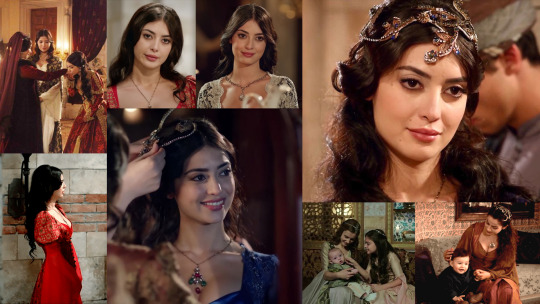
Sultana on the campaigns
After the birth of Mustafa, the sultan did not want to go anywhere without Emetullah and his son. From then on, Emetullah accompanied her sweetheart everywhere, hence her nickname became, the "itinerant sultana". The first such campaign took place in 1672, when Mehmed took the whole harem of his, his mother, his Haseki, and his sisters to Polish territory. From this trip we are left with a description of an incident in which Emetullah’s silver carriage was stuck in the mud due to bad weather on the way to the Babadag camp. The sultan could not wait for hours for the carriage to be released, so Fazıl Ahmed Pasha, the Grand Vizier, was left with his men to help the Sultana. On August 28, 1672, Kamianets-Podilskyi fell and became the property of the Ottomans. Mosque were formed from all the churches in the city, one of which was named in honor of Gülnüş. With this she became the first and only Haseki Sultan to enjoy such a privilege.
They spent a few months near the front and then returned to Edirne. However, the agreement was crossed by the Polish, so in 1673 Mehmed was forced to return to the front and took his sweetheart with him again. This is particularly noteworthy and not just because the sultans had not taken their wives on the battlefield for centuries, but because Emetullah Rabia Gülnüş was already heavily pregnant with her second son. The baby was finally born during the campaign on 31 December 1673 at Hacıoglupazarı in present-day Bulgaria. This was the only time an Ottoman prince was born near the battlefield, away from the security of the capital or the provinces. The fact is, however, that this camp was also very far from the real war.
After the success of the Polish campaign, the Sultan retreated to Edirne, where in 1675 he organized a huge ceremony in which his two sons, Mustafa and Ahmed, were circumcised and his eldest daughter, Hatice, was married off. Mehmed's appearance was reported at the event, but many praised the princes and Emetullah Rabia Gülnüş, who attended the ceremony as well. According to one agha present, the Sultana was a beautiful woman with chesnut hair. It is questionable, of course, to what extent we can believe such descriptions, since her hair was certainly covered with a veil, even if she was present. Then in 1676 Mehmed embarked on another campaign - again, of course, with his sweetheart on his side - this time to match the Russians. The aim of the campaign was to rule over today's Ukrainian - then Polish - territories. Finally, in 1681, the campaign ended with an agreement.

The first woman in the harem and the fall
Whatever the relationship between Turhan and Emetullah was, with the death of Turhan in 1683, the road to the top of the harem opened up before Emetullah. Although her large-scale construction projects, as a Haseki, began during Turhan’s life, her political career could have really gained momentum only without Turhan. There is a known case, for example, in which one of Mustafa's teachers, Feyzullah Efendi, who was very close to Emetulla committed a mistake and was faced with severe punishment. Eventually, Emetullah intervened and saved the man's life.
However, Emetullah could not enjoy the control of the harem for long. The 1680s were about a series of tragedies. The enemies of the Ottoman Empire clashed in turn and squeezed the Ottomans more and more out of European territories. This caused general dissatisfaction, and then over time, chaos, executions, financial problems spread throughout the empire, more and more rebellions set in, and even natural disasters plagued the empire. Turhan's death was practically sealed the end of Mehmed IV also. He became increasingly unpopular, and suffered the final blow in 1687. After the tragic outcome of the second battle of Mohács, Mehmed was dethroned and his younger brother, Suleiman, was put to the throne, as Suleiman II. This meant Emetullah's move to the Old Palace.
Not only did Emetullah face the loss of her power and exile, but she was separated from her beloved. A member of Mehmed’s harem, the poet Afife Kadin, at this time composed one of her poems about Gülnüş. According to the verse, Gülnüş sobbed and shouted as long as her lungs could hold, while her loved one was torn away from her and locked up. While Mehmed sobbed quietly in the kafes, his beloved cried across the wall. In another verse of hers, Afife writes, "Tell Gülnüş to wear black / to suffer in pain / While Sultan Mehmed weeps in Şimşirlik" We do not know if Emetullah and Mehmed may have met until Mehmed's death in 1693.
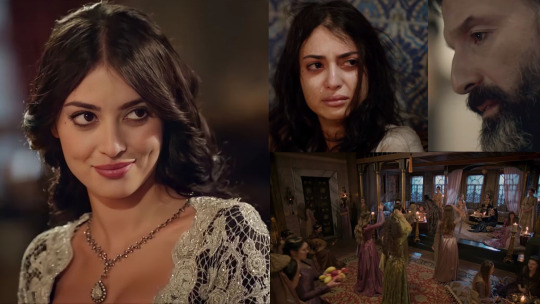
Back to the top
Due to Süleyman II's ill condition, followed by the old Ahmed II, Emetullah did not have to linger in the Old Palace for long. In 1695, barely 8 years after her retirement, Emetullah was able to return as Valide Sultan. Ahmed II died in Edirne and Mustafa II took his place as Sultan. Emetullah was then in the Old Palace in Istanbul, so thats where she received the news. As part of a huge ceremony, Emetullah went from the Old Palace to Topkapi Palace and from there to Edirne. On the way to Edirne, several bridges had to be renovated before the Valide Sultan's arrival. The costs of the bridge-renovations were recorded in the registers as Ahmed II's funeral expenses. Arriving in Edirne, her son welcomed the new Valide Sultan.
In the following years Edirne remained the de facto capital of the Empire. The sultan spent only a short period of time in Istanbul with his court, and then they were not resided in Topkapi Palace either, but preferred other palaces. Mustafa and Emetullah quickly gathered their trustworthy men around them and began to rule according to their own tastes. Thus, for example, the Feyzullah Efendi who had previously been rescued from execution by Emetullah, became the Seyhülislam. During Mustafa's reign, Emetullah built an unprecedented power for herself, her all-intertwined political influence was huge and also her son openly discussed state affairs with her. In addition, Emetullah regularly showed up among the people, leaving the harem, visiting her daughters or foundations. She lived a fairly free life. So much that at certain events she stood right next to her son, veiled but not hiding. At other times, she welcomed Seyhülislam, Grand Vizier, or other influential statesmen openly or were present at parades in Eyüb.
Emetullah’s tremendous influence over her son, the rampant corruption among statesmen, and the neglect of Istanbul all provoked the displeasure of the people. In 1703 a huge revolt broke out in the capital, but it quickly reached Edirne as well. Emetullah provided good advice to her son, trying to quickly replace any statesman who might have harmed them, but it was too late. During the rebellion Mustafa II was dethroned. The rebels refused to ascend Mustafa's younger brother, Ahmed, as he was also the son of Emetullah. They wanted to replace Mustafa II with the 11-years-old Şehzade Ibrahim, the son of Ahmed II and his Haseki, Rabia Sultan . The ulema, however, rejected this based on the boy's age, and as a polite gesture a letter was written to Emetullah asking for permission to dethrone Mustafa and replace him with Ahmed III. Although she had no real say, Emetullah responded in agreement:"All of you have requested in concord and unanimity that my majestic son Sultan Ahmed be seated on the imperial throne and that my other son Sultan Mustafa be deposed. Your petition has been complied with."
However, the dethronement of Mustafa was far from enough for the rebels. Gülnüş was demanded to leave Edirne or Topkapi Palace and retire to the Old Palace. Emetullah did indeed remain there until the circumstances calmed down enough for her to return. Perhaps she did not even regret her retreat, for Mustafa, her firstborn son, died in December 1703 of natural causes.
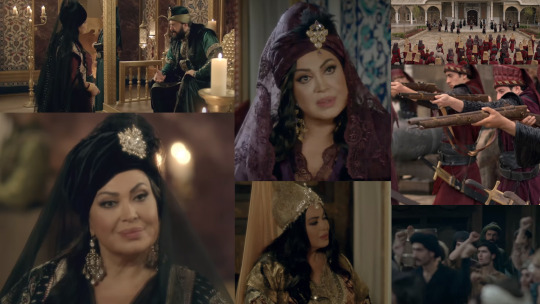
Shadow Valide
The pashas tried to keep Gülnüş away from her son and from state affairs because they feared a revenge from Emetullah on Mustafa's dethronement and subsequent death. They feared they would face a revenge campaign like the pashas who in 1648 dethroned and executed the son of Kösem Sultan, Ibrahim I. In the meantime, however, it turned out that Gülnüş did not even think of revenge. She learned from her previous mistakes and from the end of the Kösem Sultan, so she was much more careful and respectful with the pashas from then on than before. There were rewards for this.
One of Ahmed III’s first steps was to take the imperial court back to Istanbul, so Edirne ceased to be the de facto capital. To increase the sultan’s popularity among the people of Istanbul, plenty of public events were organized, such as archery competitions. Of course Gülnüş tried to help her second son, Ahmed III, but she did it all from the background. However, her participation in political life is by no means conditional. Several letters have survived, which she exchanged with the pashas during Ahmed III's reign. When one of the Grand Vizier tried to have a say in which eunuch Gülnüş would appoint to lead the harem, he quickly found himself without a position. So Emetullah Rabia Gülnüş did not give up politics at all, only she played it in a smarter and less spectacularly way.
Emetullah Rabia Gülnüş returned to the limelight once again. In 1709, during the war between the Russians and the Swedes, the Swedish king was captured and then found refuge in the Ottoman Empire. The king sought the help of the Ottomans to regain his throne. Emetullah, along with the second Vizier Damat Silahdar Ali Pasha, publicly stood by the king's request and tried to persuade Ahmed III to wage war against the Russians. The other members of the divan, such as the Grand Vizier, did not agree at all with Gülnüş's will, so a controversy ensued. Ahmed III finally, following the advice of his mother, went to war with the Russian Empire in 1711. The war ended with treaties.
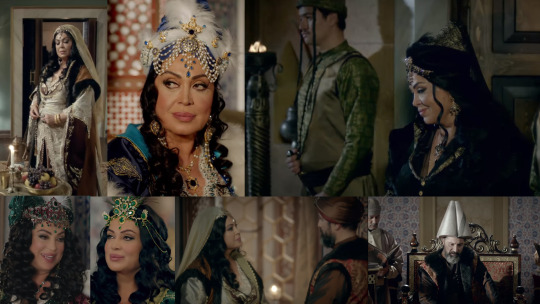
Her death and legacy
Emetullah Rabia Gülnüş followed her son from Istanbul to Edirne in the summer of 1715 to welcome there the army of the Grand Vizier, who had successfully re-conquered Morea from the Venetians. Her health here deteriorated in a few months and whatever the best doctors of the empire tried Emetullah Rabia Gülnüş died on November 6, 1715, in Edirne. Funeral prayers were held in Edirne in the presence of the Sultan, Grand Vizier, Ulema, and all important statesmen, and then her body was taken back to Istanbul, where she was buried in her own tomb on November 9th. Her turbe is particularly interesting, as it is not covered like most dynastic tombs, but open to the sky. By the way, this was built according to Emetullah's own wishes. There are plenty of plants and water in the octagonal tomb, which was probably built like that to resemble the Garden of Eden.
During her life, Gülnüş managed several construction projects, during which mosques, soup kitchens, schools, fountains and a tomb were built. But she converted several former churches into mosques also, and others were named in his honor. She also had foundations in Üsküdar, Edirne, Chios, Mecca, Medina, Kastamonu and Menemen.
Emetullah Rabia Gülnüş was the last valide sultan during the period of the Sultanate of Women. Although there were still some Valide with exceptional influence after her, no one was able to gain an influence similar to her and her predecessors anymore. It was the death of Emetullah Rabia Gülnüş that eventually completely ended the period of the Sultanate of Women. True, she was not the last Haseki Sultan, because her brother-in-law Ahmed II had a Haseki, Rabia Sultan, but the woman had already died in 1712 before Emetullah. So with the death of Gülnüş, on November 6, 1715, the more than 180-years-long period of the Sultanate of Women ended. The Sultanate of Women was followed by the Tulip era, which was one of the most peaceful periods in the history of the empire, during which Westernization began.

Used sources: B. İ. Argıt - A Queen Mother and the Ottoman Imperial Harem: Rabia Gülnuş Emetullah Valide Sultan (1640-1715); M. Ç. Uluçay - Padişahların Kadınları ve Kızları, Y.Öztuna - Devletler ve Hanedanlar, N. Sakaoğlu - Bu Mülkün Kadın Sultanları; M. Özgüleş - The Women Who Built the Ottoman World: Female Patronage and the Architectural Legacy of Gülnuş Sultan; H. G. Majer - The Harem of Mustafa II (1695-1703); J. Dumas - Les perles de nacre du sultanat; A. D. Alderson - The Structure of the Ottoman Dynasty; L. Peirce - The Imperial Harem: Women and Sovereignty in the Ottoman Empire; C. Finkel - Osman's Dream: The Story of the Ottoman Empire
* * *
Származása fiatalkora
Emetullah Rabia Gülnüş görög származású nő volt, akit minden bizonnyal a velencei-oszmán háború során fogtak el. A sors fintora, hogy a háború kirobbanása köthető volt IV. Mehmedhez, aki később Emetullah kedvese lett. I. Ibrahim 1645 nyarán hadat üzent Velencének és egy nagy török sereget küldött Krétára. A háború közvetlen oka az volt, hogy máltai kalózok fogtak el egy oszmán felségjelzésű hajót, mely több befolyásos személyt szállított. Köztük volt IV. Mehmed szoptatósdajkája és annak fia, akiket I. Ibrahim szultán nagyon szeretett. Olyannyira, hogy a szoptatósdajka fiával többet törődött, mint saját gyermekével, Mehmeddel. A háború évtizedeken keresztül zajlott, egészen 1669-ig, így pontosan nem meghatározható, hogy Emetullah mikor esett fogságba.
Emetullah egy bizonyos Deli Hüseyn Pasa ajándéka volt, aki a saját maga által ejtett krétai rabszolgákat vitte a szultáni palotába és a legjobbakat a szultán háremébe ajánlotta. Deli Hüseyn Pasa 1659-ben elhunyt, így Emetullah mindenképp ezen időpont előtt került a hárembe. Ez sajnos nem segít nekünk, ugyanis tekintve, hogy Emetullah 1660-ban már a szultán kedvence volt és ezt több éves oktatás kellett, hogy megelőzze, a legvalószínűbb, hogy 1654 előtt esett fogságba. Sokan adják meg az 1645-ös évet, mint fogságba esés, azonban ez szinte kizárt. Általában 5 év alatti gyerekeket nem fogtak el, velük több volt a baj, mint a haszon és nagy eséllyel haltak meg a hosszú és viszontagságos út során. Ha feltételezzük, hogy Emetullah nagyjából egy idős volt - vagy fiatalabb -, mint IV Mehmed (1642), legkorábban 1648-ban eshetett fogságba.

Az ágyas
Emetullah Rabia Gülnüş csodaszép fiatal nővé érett, így tökéletesen alkalmas lett a szultán szórakoztatására. Emetullah azon kevés szultána közé tartozik, akinek külsejét meglehetősen részletesen ismerjük. Az egyik követnek lehetősége volt látni Emetullah egyik ruháját és övét, mely alapján az átlagnál magasabb, de kecses nőnek gondolta a szultánát. Ugyanez a követ úgy hallotta informátorától, hogy a szultánának finom bőre és kék szeme van. Más leírások szerint fekete göndör haja volt. Élete vége felé Emetullah a beszámolók szerint inkább volt telt, mint karcsú.
Nem tudni pontosan, hogy Mehmed mikor kezdett ágyasokat fogadni és hogy Emetullah mikor vált a kedvencévé. Mehmed első gyermeke, egy kislány 1660-ban született. Közvetett bizonyítékok alapján ez a lány, Hatice, Emetullah Rabia Gülnüş első gyermeke volt. Ez alapján feltételezhetjük, hogy Emetullah a kései 1650-es években vált Mehmed partnerévé. Kapcsolatuk azonban ekkoriban még nem mélyült el igazán, hiszen Mehmed a következő időszakot a háremétől távol töltötte, sokat utazott.
A szultán nemsokkal később az egész udvartartását áthelyezte Edirnébe, ezzel gyakorlatilag mintegy de facto fővárossá tette meg az általa annyira kedvelt várost. Tökéletes időzítés volt, hogy elsőszülött fia, Musztafa itt látta meg a napvilágot 1664-ben. Mehmed annyira örült fia születésének, hogy elképesztő ajándékokkal halmozta el a gyermek anyját, Emetullah Rabia Gülnüşt és innentől kezdve sosem hagyta magára a nőt. Magával vitte a vadászataira, sőt hadjárataira is. Együtt még legalább két gyermekük született, Ahmed (későbbi III. Ahmed) 1673-ban és Fatma Emetullah 1675-ben. Mehmednek a fent említett négy gyermeken kívül bizonyosan voltak más gyermekei (Ayşe, Bayezid, Ümmügülsüm, Süleyman). Az ő anyjuk kiléte ismeretlen, lehetett Emetullah Rabia Gülnüş is, de akár más ágyasok is.
Mint a szultán kiemelt ágyasa, gyermekeinek anyja Emetullah a hárem második legmagasabb rangú asszonya volt. Viszonya a hárem első asszonyával ellentmondásos. Egyesek szerint Emetullah gonosz, erőszakos nő volt, aki rendszeresen szállt szembe anyósával, Mehmed édesanyjával, Turhan Hatice Valide szultánával. Azonban nincs erre utaló bizonyíték, sőt! Emetullah és Turhan időszakosan bizonyosan együttműködtek, hogy politikai céljaikat elérjék. 1682-ben Merzifonlu Kara Mustafa Pasa nagyvezír egyre jobban kezdte dühíteni Turhant, ugyanis próbálta ellehetetleníteni annak politikai befolyását. Azt nem tudjuk, hogy Gülnüş milyen motiváció miatt, de segített Turhannak a pasa eltávolításában. Végül sajnos Turhan előbb halt meg, minthogy a pasát lefokozták volna. Akárhogyan is, ez az együttműködés teszi valószínűtlenné, hogy Emetullah és Turhan közt rideg lett volna a kapcsolat. Mindemellett Emetullah jó viszonyt ápolt Turhan eunuchjával, Yusuf Agával, ami szintén nem lett volna lehetséges, ha a két nő nem kedveli és tiszteli egymást.
Sokan a feltételezett rideg kapcsolatért Emetullah ambícióit okolják. A legenda úgy tartja, hogy Mehmedet kedvese, Emetullah Rabia Gülnüş szultána igyekezett meggyőzni arról, hogy végeztesse ki elzárva tartott féltestvéreit és helyettük közös fiaikat tegye meg örökösének. Ismerve azonban a Mehmed és fiai közt fennálló végtelenül szoros viszonyt, nem zárhatjuk ki, hogy maga Mehmed kívánta megváltoztatni az öröklést. Akárki is volt a kifundálója, senki sem támogatta az ötletet, sem a nép, sem a pasák és Mehmed anyja, Turhan szultána sem. Turhan, hogy megóvja Szulejmán és Ahmed hercegeket a haláltól, fiát pedig a bukástól, mindig maga mellett tartotta két nevelt fiát. Ha Turhan utazott, magával vitte őket, nehogy távollétében Mehmed kivégeztesse őket.

Szultána a fronton
Musztafa születése után a szultán nem kívánt Emetullah és fia nélkül bárhová is menni. Innentől kezdve Emetullah mindenhová elkísérte kedvesét, innen ered beceneve, a "vándorló szultána" (itinerant sultan). Az első ilyen hadjáratra 1672-ben került sor, mikor Mehmed az egész háremét, anyját, Haszekijét, húgait is magával vitte a lengyel területekre. Erről az útról marad ránk egy esemény leírása, miszerint babadagi tábor felé vezető úton a rossz időjárási viszonyok miatt Emetullah ezüst fogata beragadt a sárba. A szultán nem várhatott órákat, amíg az elakadt kocsit kiszabadítják, így Fazıl Ahmed Pasa, a nagyvezír maradt hátra embereivel, hogy segítse a szultánát. 1672. augusztus 28-én Kamianets-Podilskyi elesett és az oszmánoké lett. A városban található összes templomból mecsetet alakítottak, melyek közül az egyiket Gülnüş tiszteletére nevetek el. Ezzel ő lett az első és egyetlen Haszeki szultána, aki ilyen kiváltságban részesülhetett.
Néhány hónapot töltöttek a front közelében, majd visszatértek Edirnébe. A megkötött egyezséget azonban a lengyelek keresztülhúzták, így 1673-ban Mehmed kénytelen volt visszatérni a frontra és magával vitte kedvesét is. Ez azért különösen említésre méltó, mert azontúl, hogy a szultánok évszázadok óta nem vitték harctérre asszonyaikat, Emetullah Rabia Gülnüş már előrehaladott terhes volt második fiával, akit végül a hadjáraton szült meg 1673. december 31-én Hacıoglupazarınál, a mai Bulgária területén. Ez a valaha volt egyetlen olyan eset, amikor egy oszmán herceg a hadszíntéren született meg, távol a főváros vagy a provinciák biztonságától. Tény azonban, hogy ez a tábor is igen távol volt a valódi fronttól.
A lengyel hadjárat sikere után a szultán Edirnébe vonult vissza, ahol 1675-ben hatalmas ünnepséget szervezett, melyen két fiát Musztafát és Ahmedet körülmetélték, legidősebb lányát Haticét pedig kiházasította. Az eseményen beszámoltak Mehmed külleméről, de sokan méltatták a herceget és Mehmed mellett az ünnepségen résztvevő Emetullah Rabia Gülnüşt is. Az egyik jelenlévő szerint a szultána gesztenyebarna hajú, gyönyörű nő volt. Kérdéses persze mennyire hihetünk az ilyen jellegű leírásoknak, hiszen haját egészen biztosan fátyol fedte, ha jelen volt is. 1676-ban aztán Mehmed újabb hadjáratra indult - természetesen ismét kedvesével az oldalán -, ezúttal az oroszokkal kívánt megmérkőzni. A hadjárat célja az mai ukrán - akkori lengyel - területek feletti uralom volt. Végül 1681-ben megállapodással zárult le a hadjárat.

A hárem első asszonya és a bukás
Bármilyen volt is Turhan és Emetullah kapcsolata, Turhan 1683-as halálával megnyílt Emetullah előtt az út a hárem csúcsára. Bár nagyszabású Haszekiként végzett építési projektjei még Turhan életében elkezdődtek, politikai karrierje ekkor lendülhetett meg igazán. Ismert például egy eset, mikor Musztafa egyik tanítója - aki igen közel állt Emetullahoz - Feyzullah Efendi hibát követett el és súlyos büntetés volt kilátásba helyeztve számára. Végül Emetullah közbelépett és megmentette a férfi életét.
Emetullah nem élvezhette azonban sokáig a hárem irányítását. Az 1680-as évek a sorozatos tragédiákról szóltak. Az Oszmán Birodalom ellenségei sorra fogtak össze egymással és szorították egyre kintebb az oszmánokat az európai területekről. Ez általános elégedetlenséget okozott, majd idővel káosz, kivégzések, anyagi problémák terjedtek el mindenhol a birodalomban, egyre több lázadás indult útjára és még természeti katasztrófák is sújtották a tragikus helyzetben lévő birodalmat. Gyakorlatilag már anyja halálával megpecsételődött Mehmed sorsa, egyre népszerűtlenebb lett, a végső csapást pedig 1687-ben szenvedte el. A második mohácsi csata tragikus kimenetele után Mehmedet trónfosztották és öccsét, Szulejmánt ültették trónra, aki így évtizedekig tartó elzárt élete után megkezdhette uralkodását II. Szulejmán néven. Ez egyet jelentett Emetullah Régi Palotába való költözésével.
Emetulláhnak nem csak a hatalma elvesztésével és száműzetéssel kellett szembenéznie, de elválasztották őt kedvesétől. Mehmed háremének egy tagja, a költő Afife Kadin ekkoriban komponálta egyik Emetullah Rabia Gülnüşről szóló versét. A vers szerint Gülnüş szultána addig zokogott és kiáltozott, mikor kedvesét a szultánt elszakították tőle és elzárták, amíg csak bírta a tüdeje. Mehmed pedig csendben zokogott a kafesben, míg szerelme a fal túloldalán sírt. Egy másik versében azt írja "Mondd Gülnüşnek, viseljen feketét / hogy abban szenvedje el fájdalmát / míg Mehmed szultán Şimşirlikben sír". Nem tudjuk, hogy Emetullah és Mehmed találkozhattak e még Mehmed 1693-as haláláig.

Vissza a csúcsra
II. Szulejmán szultán beteges állapota miatt, majd az őt követő II. Ahmed kora miatt nem kellett Emetullahnak sokáig a Régi Palotában senyvedni. 1695-ben, alig 8 év után Emetullah valide szultánaként térhetett vissza. II. Ahmed Edirnében hunyt el és a szintén jelenlévő II. Musztafa vette át a helyét szultánként. Emetullah ekkor Isztambulban a Régi Palotában volt, itt kapta meg a hírt. Emetullah hatalmas ünnepség keretei között a Régi Palotából a Topkapi Palotába ment, onnan pedig Edirnébe. Az Edirnébe való út során több hidat kellett megújítani a valide szultána előtt, melyek költségeit mind II. Ahmed temetési költségeiként vezettek fel a jegyzőkönyvekbe. Edirnébe érve fia üdvözölte az új valide szultánát.
A következő években is Edirne maradt a birodalom központja, csak rövidebb időszakot töltött az udvar Isztambulban és akkor sem a Topkapi Palotában voltak, hanem más palotákat részesítettek előnyben. Musztafa és Emetullah gyorsan maguk köré gyűjtötték megbízható embereiket és saját szájízük szerint kezdtek uralkodni. Így lett például Seyhülislam abból a Feyzullah Efendiből, akit korábban már egyszer Emetullah megmentett a kivégzéstől. Musztafa uralkodása alatt Emetullah sosem látott hatalmat épített magának, mindent átszőtt politikai befolyása de fia is nyíltan megvitatta vele az államügyeket. Emellett Emetullah rendszeresen mutatkozott az emberek közt, hagyta el a háremet, látogatta meg lányait vagy alapítványait. Meglehetősen szabad életet élt. Olyannyira, hogy bizonyos eseményeken egyenesen fia mellett állt elfátyolozva, de nem elbújva. Máskor a Seyhülislamot, nagyvezírt vagy más befolyásos államférfiakat fogadott nyíltan vagy parádékat tekintett meg Eyüb városrészben.
Emetullah hatalmas befolyása fiára, az államférfiak közt dívó korrupció és Isztambul elhanyagolása mind a nép nemtetszését váltották ki. 1703-ban hatalmas lázadás tört ki a fővárosban, de gyorsan elérte Edirnét is. Emetullah jó tanácsokkal látta el fiát, igyekeztek gyorsan leváltani minden államférfit, aki kárt okozhatott volna nekik, de már késő volt. A lázadás során II. Musztafát trónfosztották. A lázadók azt is elutasították, hogy Musztafa öccsét, Ahmedet emeljék trónra, hiszen ő is Emetullah fia volt, helyette II. Ahmed és Haseki Rabia szultána 11 éves fiát, Ibrahim herceget akarták a trónra ültetni. Az ulema azonban ezt elutasította a fiú korára való tekintettel és illedelmes gesztusként levelet írtak Emetullahnak, melyben engedélyét kérték Musztafa trónfosztásához. Bár nem volt valódi beleszólása, Emetullah beleegyezően válaszolt.
A lázadóknak azonban Musztafa trónfosztása távolról sem volt elég. Követelték, hogy Gülnüş hagyja el a Topkapi palotát és vonuljon vissza a Régi Palotába. Emetullah valóban ott maradt, amíg a körülmények nem nyugodtak meg eléggé visszatéréséhez. Talán nem is bánta az elvonult életet, ugyanis Musztafa, elsőszülött fia 1703 decemberében természetes okok következtében elhunyt.

Árnyék Valide
A pasák azért igyekeztek Gülnüşt távol tartani fiától és az államügyektől, mert attól tartottak bosszút állna rajtuk Musztafa trónfosztása és későbbi halála miatt. Féltek, hogy egy olyan bosszúhadjárattal találnák szembe magukat, mint azok a pasák, akik 1648-ban Köszem szultána fiát, Ibrahimot trónfosztották és kivégezték. Gülnüşről azonban időközben kiderült, hogy eszében sincs bosszút állni. Tanult az esetből és Köszem szultána halálából, így sokkal óvatosabban, tisztelettudóbban viselkedett a pasákkal, mint korábban. Ennek meg is lett az eredménye.
III. Ahmed egyik első lépése az volt, hogy a birodalmi udvartartást újra visszavitte Isztambulba, így Edirne megszűnt de facto fővárosnak lenni. Hogy a szultán népszerűsgét növeljék Isztambul népe között, rengeteg nyilvános eseményt szerveztek, például íjászati bemutatókat. Természetesen Gülnüş második fia, III. Ahmed uralkodása során is kényelemben élt és igyekezett segíteni fiát, de mindezt a háttérből tette. Részvétele a politikai életben azonban egyáltalán nem feltételes. Fennmaradt több levele is, melyet a pasákkal váltott III. Ahmed uralkodása során. Mindemellett, amikor az egyik nagyvezír megpróbált beleszólni abba, hogy Gülnüş melyik eunuchot nevezi ki a hárem élére gyorsan pozíció nélkül találta magát. Emetullah Rabia Gülnüş tehát egyáltalán nem hagyott fel a politikával, csak azt okosabban és kevésbé látványosan tette.
Emetullah Rabia Gülnüş még egyszer visszatért a rivaldafénybe. 1709-ben az oroszok és svédek közti háború során a svéd király fogságba esett, majd az Oszmán Birodalomban talált menedékre. A király az oszmánok segítségét kérte, hogy visszaszerezhesse trónját. Emetullah a második vezír Damat Silahdar Ali Pasával karöltve nyilvánosan álltak a király kérése mellé és igyekeztek rávenni III. Ahmedet, hogy vállaljon háborút az oroszokkal. A divan más tagjai, így a nagyvezír egyáltalán nem értettek egyet Gülnüş akaratával, így vita alakult ki. III. Ahmed végül az édesanyja tanácsát követve bocsátkozott 1711-ben háborúba az Orosz Birodalommal, mely egyezményekkel zárult.

Halála és hagyatéka
Emetullah Rabia Gülnüş 1715 nyarán követte fiát Isztambulból Edirnébe, hogy ott üdvözöljék a nagyvezír seregét, aki sikeresen hódította vissza Moreát a velenceiektől. Egészsége itt néhány hónap alatt leromlott és bármivel is próbálkoztak a birodalom legjobb orvosai Emetullah Rabia Gülnüş 1715. november 6-án, Edirnében meghalt. A temetési imákat Edirnében mondták a szultán, nagyvezír, ulema és minden fontos államférfi jelenlétében, majd testét visszavitték Isztambulba, ahol saját türbéjében temették el november 9-én. Türbéje kifejezetten érdekes, ugyanis nem fedett, mint a legtöbb dinaszitkus türbe, hanem az ég felé nyitott. Ez egyébként Emetullah saját kívánsága szerint épült így. Az oktagonális türbében rengeteg a növény és a víz, mely valószínűleg amiatt épült így, hogy hasonlítson az Édenkertre.
Élete során Gülnüş több építkezési projektet menedzselt, melynek során mecset, leveskonyha, iskola, kút, türbe épült. De több korábbi templomot építtetett át mecsetté, másokat pedig tiszteletére neveztek el. Emellett volt alapítványa Üsküdarban, Edirnében, Chiosban, Mekkában, Medinában, Kastamonuban és Menemenben.
Emetullah Rabia Gülnüş volt az utolsó valide szultána a Nők szultánátusának időszakában. Bár utána is akadt néhány kivételes befolyással bíró Valide, az övéhez és elődeihez hasonló befolyást senkinek sem sikerült többé szerezni. Emetullah Rabia Gülnüş halála volt az, amely végül teljesen lezárta a Nők szultánátusának időszakát is. Igaz, nem ő volt az utolsó Haszeki szultána, mert sógorának II. Ahmednek volt egy Haszekije, Rabia Sultan, a nő már Emetullah előtt, 1712-ben meghalt. Gülnüş halálával, 1715. november 6-n lezárult az a több, mint 180 éves időszak, mely során befolyásosabbnál befolyásosabb nők váltották egymást az Oszmán Birodalom előkelőségei között. A Nők szultánátusát a Tulipán éra követte, mely az egyik legbékésebb időszaka volt a birodalom történetének, és mely során elindult a nyugatosodás a birodalomban.

Felhasznált források: B. İ. Argıt - A Queen Mother and the Ottoman Imperial Harem: Rabia Gülnuş Emetullah Valide Sultan (1640-1715); M. Ç. Uluçay - Padişahların Kadınları ve Kızları, Y.Öztuna - Devletler ve Hanedanlar, N. Sakaoğlu - Bu Mülkün Kadın Sultanları; M. Özgüleş - The Women Who Built the Ottoman World: Female Patronage and the Architectural Legacy of Gülnuş Sultan; H. G. Majer - The Harem of Mustafa II (1695-1703); J. Dumas - Les perles de nacre du sultanat; A. D. Alderson - The Structure of the Ottoman Dynasty; L. Peirce - The Imperial Harem: Women and Sovereignty in the Ottoman Empire; C. Finkel - Osman's Dream: The Story of the Ottoman Empire
#Emetullah Rabia Gülnüş#emetullah rabia gulnus#emetullah rabia#emetullah#rabia#rabia gülnüş#gülnüş#gulnus#Mehmed IV#turhan hatice sultan#turhan hatice#turhan#ibrahim I#sultanate of women#Ahmed II#mustafa ii#ahmed iii#Süleyman II#Suleiman II#ayşe hafsa#Haseki Hürrem Sultan#ayse hafsa sultan#haseki nurbanu sultan#nurbanu valide sultan#Nurbanu Sultan#haseki safiye sultan#Safiye#safiye sultan#handan sultan#halime sultan
60 notes
·
View notes
Note
Leyla Feray was a perfect "Ayşe Sultan", Farah Zeynep is not that pretty plus the role of a sultana didn't suit her and of course Farya as a character sucks ! Still bitter about Tims's casting for Turhan Hatice and for how they portrayed her and she only appeared in 3 episodes Ibrahim's reign deserved its own season
I agree Anon. Harem didn’t play an important role during Murad’s reign, so to be honest I would be satisfied with having only Ayşe as a developed character. Harem during Ibrahim’s role played a HUGE role and the fact that we didn’t get all the harem dynamics of that period explored properly is my huge regret and I can bet show’s creators feel the same because they obviously planned for Season 3 devoted wholly to Ibrahim’s reign.. but such is Turkish TV market now and they still delivered a story of Kösem’s life that made sense, which is more you can tell of many TV shows nowadays, even those with huge budget and safe position like Game of Thrones that HBO would have likely prolonged as much as they could, but D&D were certain they had enough time to wrap everything up properly lol. So in those conditions,not knowing when they may get axed (and Turkish shows are filmed like two weeks in advance only), I still appreciate what they did… Now that my initial expectations about whole season of Turhan/Kösem rivalry, Ibrahim’s harem, Turhan of my dreams are more in past, I’m more able to appreciate what we got in that conditions eh.
Devoting so much time to Farya and Murya was HUGE mistake, since it didn’t save the ratings by bringing FZA’s fanbase etc., and it truly stole a lot of precious screentime later. The pacing issues are in MYK from start – back in S1 they introduced Beren earlier than planned and then rushed to end S1 with Kösem becoming regent because they weren’t sure they would get renewed. Maybe it’s crying over spilt milk now, especially since they are obviously aware that they had made a huge mistake – Farya’s screentime was clearly strongly reduced after 10 episodes and after she was removed, she was practically never mentioned again, like they pretended she had never existed lol.
Mhm I don’t think actresses’ appearance is of importance here, sultanas were normal girls, I know it is often assumed that they had to be pretty to captivate the padişah, but it was not always the case - Hürrem apparently wasn’t that conventionally pretty, but managed to charm Suleiman so much regardless. And each sultan had his own preferences. There isn’t something like “a sultana look”. I hear people talking “this actress is too pretty to play a subject, not a sultana” and I’m like ???? Royal blood doesn’t make you pretty either.
I think Leyla was absolutely fine. I liked her cutesy image in contrast to Murad’s violent nature. You can see why this girl “brought him peace” and why he ultimately destroyed her… just episode before she makes the big mistake and helps Gülbahar out, Murad threatens her to become her nightmare after Farya told him about her suspicions. She was soo scared, she was willing to do everything just not to face Mu/rat’s /spelling intentional/ wrath. And then she regretted what had done so much when she heard about people who suffered in the fire and wanted to fight Gülbahar as mother of Murad’s kids and his woman… and poor thing ultimately got exposed for wanting to fix things… #AyseDeservedBetter
I’m not satisifed with the Turhan we got, but after reading more stuff about Kösem vs Turhan conflict I’m now against the “Turhan was innocent cookie, who only jumped to her son’s defence” thing – it’s a clear example of “history being written by winners” thing. Turhan was definitely very good at propaganda – relationship between her and Ibrahim was surely tense and full of mutual dislike, and Mehmed ascending the throne and Ibrahim being dethroned surely was a good thing for her – yet in correspondence to statesmen that she wanted to bring to her side she described herself “as poor suffering widow, who just wants to punish those who killed her beloved husband”, among which she meant Kösem. There was even an occurrence when one of statesmen supporting Turhan went to Kösem to accuse her of killing Sultan Ibrahim and putting all blame on her, which reportedly shook Kösem very much. While Kösem likely did make moves to dethrone Mehmed, it’s very possible that the poisoning thing was invented by Turhan and her people to rally support. Reports put blame on “misinformation” on Suleiman Aga, who was treated as person inciting the showdown, but we know Suleiman Aga served Turhan, and it was a natural thing that servants of Imperial figures were blamed because nobody dared to accuse the actual Valide.
Turhan as Valide Sultan did not only manage harem, but was involved in state matters and the double rule often made it harder for Kösem to stabilise Empire. Turhan wasn’t deprived of being Valide Sultan; Kosem’s position was simply new & unprecedented and allowed her to be regent. While mothers began to play the role of regent recently (Kösem for Murad, Halime unofficially for Mustafa, Handan as co-regent together with Ahmed’s lala, even Mehmed III leaving the affairs in Safiye’s hands when he went on campaign to Hungary), there was no law on this and previously e.g. there was more inclination for Grand Vizier in this role.
In the end, they were both morally grey because while Kösem likely didn’t plan to poison Mehmed, of course there was always risk of him losing his life if any problems ensued following deposition, as the Ibrahim case showed.
Still, the innocent cookie defender of her son Turhan vs. evil hag Kösem narrative is not the true one.
We also must remember that:
Discretion prevented Ottoman writers from criticizing royal mothers (they did not record the hostile barbs directed by Ottoman statesmen at queen mothers and favorites which made their way into European accounts), but they did not hesitate to employ invective in he case of lesser women of the sultan’s harem. Naima, so careful to defend the young queen mother Turhan, criticized other concubines of the “mad” İbrahim with relish.
Taken from: Leslie Peirce, The Imperial Harem: Women and Sovereignty in the Otoman Empire.
I’ve found some evidence for Turhan being groomed by Kösem and Turhan’s involvement in politics even during Ibrahim’s reign (namely in connection with the Crete war), so while we don’t know much about the relationship between the two women before Mehmed’s reign, there is some evidence supporting MYK’s direction. Leslie Peirce states that Kösem groomed Turhan and Thys-Senocak mentions that Atike chose and trained her.
However, as a new slave woman in the palace, a gift of Kör Süleyman Pasha to the valide sultan Kösem, she had been trained by Atike Sultan, a sister of Murad IV, and groomed by Kösem, who presented her to her son.
Taken from: Leslie Peirce, The Imperial Harem: Women and Sovereignty in the Otoman Empire. Peirce also reiterates that Kösem groomed Turhan in her short article entitled Gender and Sexual Propriety in Ottoman Royal Women’s Patronage.
Training by Atike could be also on Kösem’s request, though we cannot say for certain Atike was Kösem’s daughter, but yet again Kösem seemed to pretty much take care of whole dynasty, not only her own children. It is interesting because the position of the mother of eldest son’s gained importance due to switch to seniority and we know for certain Turhan wasn’t Ibrahim’s favourite consort – but maybe again he was attracted to her at first and the relationship deteriorated later. Due to her being mother of eldest son, Turhan had to be aware that being Valide is in store for her, and Kösem also had to accept the fact.
The fact is that with four episodes the showrunners decided to focus more on the already established characters and Turhan got pretty much sacrificed for it – after all, it was Kösem’s story. I get what they did for abridged story purposes, but what I saw on screen did not reflect my imaginations of historical Turhan.
In the end, MYK Turhan represented an extreme version of a person brought up in Ottoman harem. She was completely cold and almost entirely devoid of human emotions, save in some scenes with her children or her sadness upon Ibrahim preferring other concubines. She was truly unscrupulous and desperate to get to the highest top aka becoming regent for her son, which meant he had to become padişah while he was still a minor. She truly wanted to have it all, even if she had a lot compared to other harem girls – she was a chief haseki with high position given to her by her mother-in-law, who truly treated her exceptionally compared to other Valides we saw – she shared her power with her, taught her political stuff and introduced her to political world, involving her in her own affairs and even taking her to secret councils with her. Kösem was undoubtedly aware that in light of Ibrahim’s illness she had to keep the mother of eldest prince satisifed&feeling safe because padişah like Ibrahim was an easy target for deposition. Not only Turhan had safe position due to seniority succession rules – Kösem clearly supported her and wanted her to be her successor, e.g. backed her up in the Zarife conflict. Yes, Ibrahim had other favourites, but he was a weak sultan and he wasn’t interested in this stuff at all – he just wanted to have fun with other girls and ignored Turhan, but he wasn’t politically involved enough to try to prevent Turhan from becoming next Valide because he simply didn’t give a damn most of the time.
Turhan’s going against Kösem was a huge & risky gamble, also for her son. It’s one thing to never trust anyone fully and be on your guard, and another to go on removing everyone, so whole rule is in your hands. While we know that relations between Ibrahim&Turhan were tense, there wasn’t any repeated pattern of abuse against her or their son – Ibrahim’s outburst and throwing Mehmed justifiably shook Turhan up, but it was clear it was one-time incident that stemmed more from Ibrahim’s illness than any sort of malice or sadism. He mostly simply ignored Turhan and didn’t want to spend time in her company. Perhaps Ibrahim being a weak padişah was also why Turhan looked at him with contempt because she couldn’t accept how this man stood higher in hierarchy than her, which wounded her pride additionally. Thus said, if her primary motive had been as she said fear of Ibrahim, I don’t think she would have gone against Kösem. Kösem was after all the person who defended her to Ibrahim, tried to calm him down with regards to Turhan and she obviously supported Turhan as next Valide. Additionally, when Kösem actually controlled Ibrahim and his behaviour – later Atike didn’t care, people who were trying to use him and make him crazier for their purposes achieved their goal. Turhan purposefully wanted to make him crazier and crazier to dethrone him and now she was in the palace without her biggest former supporter. Ibrahim was definitely in far worse mental condition after Kösem’s exile and Kemankeş’ removal. We got the taste of the danger when Ibrahim threatened to strangle Mehmed during the coup – and then we finally saw fear in Turhan’s eyes. But it was she who allowed the situation to boil down to this. Turhan’s backstabbing to Kösem wasn’t only a betrayal to a person who always supported her&did a lot to her (and it was something even Ibrahim highlighted after Kemankeş’ “execution” and since he also had beef with his mother at that point, it’s hard to take his words as biased), but also her sacrificing whole nation due to striving to make Ibrahim’s reign fail so much that he would be undoubtedly deposed.
Turhan’s final win isn’t so much a triumph of very well-thought-out long-term strategy, but luck, totally unscrupulous nature, not taking into account that any bystanders might be harmed, and Kösem making a fatal mistake in the end. Until the last stand, Kösem always managed to ultimately outsmart her, and Turhan’s final victory is only due to raw force, Kösem making a fatal mistake&Kuşçu’s betrayal for reasons Kösem didn’t deserve.
In the end, Turhan and her people represented raw power which adheres to no rules or honour. Not only did they kill so many innocent people, but also showed no rules in the final stand – Kösem is strangled on the harem floor and her body is plundered (a historical fact, sadly), and Turhan only stays on balcony with devilish smile over the slaughtered palace. Köprülü does not face the elderly Kemankeş himself, but waits until his people defeat him to slice his throat. Haci is also murdered in unnecessarily cruel way by having his neck twisted in front of Tuhan bearing her stone cold face as she usually does. Turhan was presented as pretty much extreme product of that system – someone who is always coldly calculating, showing little human emotions (maybe only towards her kids) and only focused on achieving one’s goal without any scruples, and is unable to bond with anyone other than her kids. Same with people surrounding her, there are no strong, touching & genuine relationships like in Kösem’s team, which is based on loyalty that may mean even paying with death for it. There’s strong friendship between Haci & Kösem, same with Kemankeş and Deli Hüseyin, Kösem and Kemankeş deeply and truly love each other until the end, Hüseyin also prefers to die than to support Turhan. Even Lalezar’s “betrayal” is only about not letting an innocent child die, not wanting to support Turhan or switch sides for her personal gain. In a way, Turhan functions as some symbol of end of Empire, same with the depressing final shots, which is also accentuated in Kösem’s final monologue: ‘The lights have gone out, no right, no left, no death, no back, no forward, no top, no bottom (…) ” . I can see the rationale – it was first and foremost Kösem’s story, moreover a story that needed to be abridged.
However, as I said, Turhan is a real-life historical figure that actually did good things for the Empire, continued Kösem’s legacy and had her achievements, that’s why historical Turhan can never be simply a destructive force in my mind, and it’s probably the highest divergence between historical figure and show figure I have in my mind as far as MY&MYK are concerned.
We see some glimpses of Turhan actually taking her responsibilities seriously in the final episode – she decides to spare Mehmed’s brothers (which actually serves pretty much as plot twist taking into account how her character has been portrayed) and declares she intends to take care of the state. Ironically, while Kösem paid for politically training Turhan & introducing her to political world with her life, at least even her ultimate enemy wanted to honour her legacy & obey anti-fratricide law & was prepared for ruling. It was a posthumous win for Kösem here.
Of course the way historical Turhan took power from Kösem was questionable – it was full of brutality, purges, and it’s hard to imagine it was all without knowledge of her and her closest associates. /Still we know that Turhan likely didn’t kill harem girls that served Kösem, but got them married off instead as Kumrular writes in her Kösem biography/. However, she also proved capable in taking care of state and dynasty and since Mehmed was pretty much an obedient momma’s boy, she had much easier task than Kösem to for example persuade him not to kill his brothers.. honestly, try to control someone like Murad, it was a huge success Kösem managed to save Ibrahim.
I think that the portrayal of Turhan and her people may stem from not only brutal purges that followed Kösem’s death, but also from the period after Turhan appointed Köprülü the Grand Vizier – Peirce compares some of his methods to Murad’s and this period to Murad’s reign. While it was Köprülü who used bloody methods, we can guess that Turhan would have not let him stay GV if she had not accepted it. It is curious how Turhan/Murad emerged a pretty popular crackship in MYK… I was always like “they gave us Turhan who seems like a perfect match for Murad”.. just that her ruthlessness does not stem from anger, but more from cold detachment (fire and ice LMAO). I know some like to refer to Turhan as “Iron Lady”, so I suppose it was what MYK creators intended. /There is of course some anger in her too - when Ibrahim told her that she was just a coward hiding under his mother’s skirts… you just knew she would NEVER let it slide and prove to him & the rest of the world she didn’t need Kösem to stay on top./
The more I think the more I’d really love to see Müge Boz as Turhan, since Turhan wasdescribed as pretty unassuming and that was also why she was able to rally supporters. It would be cool to see Kösem facing a girl looking like young her, but not innocent… yet using her innocent image. And again we should have seen more of her showing care for state. I’m actually glad we didn’t get the simple Kösem turns into Safye and encounters an innocent Anastasia that we all expected. Now I think we needed something more complex, and as I mentioned it Kösem truly didn’t turn into Safiye, while many of Turhan’s actions (like mass slaughter in harem) resemble Safiye more – yet later her son is truly in danger, so there’s some rationale in that and we see some of Kösem’s legacy in her declaration to spare Mehmed’s brothers and take care of the state.
Likely it was intentional to make Turhan so much like the opposite of innocent Nasya.
But in the end, while there are hints of Kösem legacy being preserved (Turhan clearly wants to obey anti-fratricide law), Turhan pretty much served as a symbol of future fall of Empire because the final images of slaughtered people and her smirking on balcony in her slay kween (pretty pretentious) attire, accompanied by the above mentioned monologue, pretty much give a glimpse of apocalypse. /And LBR she claimed she had started the whole conflict for her son… then why the fuck she stands shouting to “bend the knee or die” & “show no mercy” or grins on the balcony instead of sitting with her son or at least checking up on him?/
It’s kinda fitting end for Kösem story, where she was the protagonist, especially when we see how yellow filter & fairytale elements from first episodes of MYK (which gradually become less bright) to the total darkness and atmosphere of doom of final episode. Still, as I said, Turhan Sultan is a historical figure that deserves more.
In a way, we were by default robbed of a satisfying depiction of Turhan by the mere fact that Ibrahim’s regin was abridged to 4 episodes – we should have got her early days in harem, her growing up etc., but I think at this point I decided to stop crying over spilt milk, I think, even though the mere fact that some fake princess got 22 episodes and Turhan 4 is always gonna hurt.
- Joanna
#turhan hatice sultan#magnificent century kosem#muhteşem yüzyıl kösem#muhtesem yuzyil kosem#ottoman history#kosem sultan#history#answered#mods opinions
42 notes
·
View notes
Text
The Rise and The Fall of Kosem Sultan (Part II - Episode I)
Kosem Sultan: Rise to Power Episode I

continued from ⤵️
Anastasia left Ahmed's Room and went to face rebels. She reached there and told them that Sultan and Shehzade Mustafa are alive however their health is in critical condition. She assured them that she takes guarantee that Palace is telling truth and is not hiding anything. She also told them to go back and return after sometime to see Sultan well and fine. When rebels started to disperse one of them shot Anastasia and she fell down. After a moment Anastasia became conscious and stood up. This was due to Taveez (object of protection) given by Aziz Mehmud Hudayi. Anastasia came back to the palace and was taken to palace clinic for medical aid. The rebels finally dispersed and on the other hand Anstasia's father reached Isatanbul in search of his daughter. Next morning everyone praises Anastasia including Valide Sultan. She is presented as the Hero in front of everyone in the palace and then due to her heroic acts she was named Kosem (the leader). Ahmed's condition improved but he was unconscious. There was chance of another rebellion so for speedy recovery Kosem went to Fortune Teller Magician who gave her a medicine and told her that Ahmed will be fine only at one cost, that Kosem will see the death of all her loved ones, she accepted this and took the medicine. On the other hand her father is still in search of her. Safiye made pact with Giray brothers, the Crimean Hans (thinking that Ahmed and Mustafa would die soon) that Sahin Giray will acsend the ottoman throne. The coronation preparations were complete. On the same day of Sahin's coronation Ahmed suddenly woke up fine and in good health. When Sahin was about to be declared Sultan, by everyone's surprise Ahmed came to durbar, beheaded the minister and proclaimed that he's still the Sultan and will punish everyone who created problems during his illness. Kosem then came to meet him and he called her Nasia, she replied that she is not Nasia, Anastasia, Hatice or Mahpeker. From now onwards she is KOSEM.

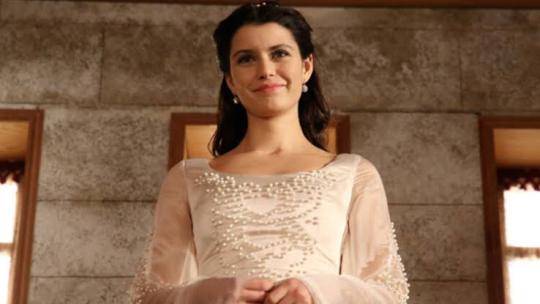

Kosem breaks her alliance with Safiye after watching her actions during Ahmed's illness. Kosem's father found her through the help of Alexander (now Iskender) but Safiye learns about this and arrests him. Kosem learns that it was Fahriye who poisoned Ahmed and Mustafa due to her love interest. Safiye threatens her that she'll kill her father if she tells this to Sultan. She uses Kosem and then kills her Father. Fahriye is not married with Mehmed Giray (her love interest) instead she is married to Dervaish Pasha (closest to Ahmed) which Ahmed approved and wedding preparations began. On the other hand Dervaish Pasha confesses his love for Valide Sultan Handan to her about which she's angry but she spares his life despite this. Kosem pledges to take revenge of her father. Cennet Kalfa (Safiye's Confident) is told by Kosem that the reason of her burnt face is Safiye. When she was Mehmed III concubine, it was Safiye who schemed against her and burnt her face. Cennet after learning this switched her side secretly and gives Kosem the ring of her mother which her father brought from Tinos which Safiye kept with her. Kosem threatens. Safiye that she will tell everything to Sultan but she didn't give any attention to her. Kosem schemed and caught the letter of Fahriye in which it was written that she poisoned Sultan. She showed this letter to Safiye and told her that she will return this letter only if she leaves the Topkapi Palace and shifts to Aski Palace. Safiye agreed and left for Aski Palace. On her way when she unfolded Fajriye's letter given by Kosem she found out that it was simple paper and Kosem had played with her and the letter is still with her. Cennet confesses that she helped Kosem and she officially changed sides. Sultan gives Kosem the crown of great Hurrem Sultan. Kosem walks in the palace as if shes the queen. Kosem hands over the letter to Ahmed and told him all the truth about Fahriye. He despite of this becomes disappointed from Kosem as he said that he only liked her due to her Innocence but now she's no more innocent as she is also scheming like other Sultanas.
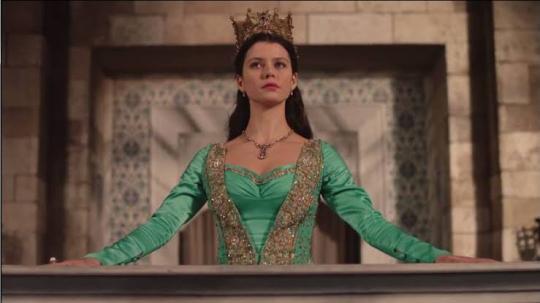
On the other hand Mahfiruz gives birth to Sultan's first child a son named Osman. This created jealousy in Kosem's heart. Sultan is not talking to Kosem and she is not allowed to visit him nor to come in his room. Kosem learns that she's pregnant and soon she gives birth to Sultan's second son Mehmed. Sultan is still not taking to her so she decided to tell him whole truth about the murder of her father. She told him that she only took revenge from Safiye because she killed her father. After learning this his heart melts and he is reunited with Kosem. Fahriye on the other hand takes refuge in Mahmood Hudayi Welfare where it is not allowed to kill anyone. Ahmed tries to get her out but she didn't. Kosem again schemed with Zulfikar Pasha and Mehmed Giray and made her come out of the welfare and then arrested her. Sultan praises the efforts of Kosem and Zulfikar. She is presented to Sultan and she pleads him to forgive her. He tells him that he'll think about this matter. Fahriye settles back in her place with Dervaish Pasha where he executes her on the order of Sultan Ahmed. Safiye when learns about her daughter's executions goes into. Deep sorrow and pledges to take revenge from Ahmed.
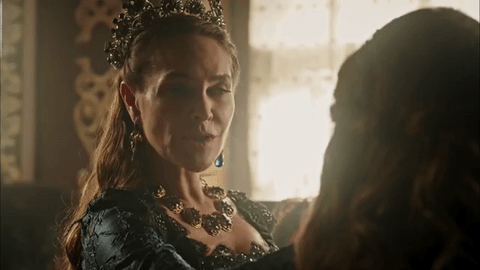
Ahmed goes to hunt with his guards where he faces assassination attempt on himself but he was saved by Dervaish who put his life in danger. Safiye starts rebellion in palace. She told Jannisaries that Ahmed is no more. They believed and sided with her. She planed to put Mustafa on throne. Kosem saves the life of Valide Sultan, Osman and Mehmed however unfortunately Mahfiruz is killed by Safiye's guards. Safiye ordered execution of Kosem but she is spared by Bulbul (Safiye's Agha) who admired her. She along with Valide and her son's took refuge in a girl's house named Meleki. At the time of Mustafa's crowning Ahmed, by everyone's surprise appeared and kills pashas who sided with Safiye. Zukfikar and Mehmed Giray sided with Ahmed. Safiye tries to poison herself but she is caught by Ahmed who then imprisoned her. All her accessories and property was taken away. Humashah (Safiye's daughter) arrives in the capital.


Kosem learns from Halime (mother of Mustafa) that Handan and Dervaish are in love with each other and that Dervaish killed Mehmed III. Kosem schemed again but now against Dervaish and Handan, she managed to tell Sultan about Dervaish. Humashah on the other hand falls in love with Zulfikar Pasha. She's living in the palace and was convincing Sultan to release Safiye. Sultan learns that Dervaish killed Mehmed III only to save Ahmed's life however Ahmed executed Dervaish. (Who was then Prime minister) on charges of Sultan's murder. Handan commits suicide in fear that Ahmed will learn about her love and also because she was in deep sorrow after the execution of Dervaish. Palace mourns the loss of Valide Sultan. Huamshah is made incharge of Harem.

After sometime Safiye is released. Humashah's husband comes to. Capital and asks Sultan to let Humashah go with him but she refuses. Humashah and Safiye learns that Iskender is Shehzade Safiye's son and Humashah's brother. Kosem learns that she is again pregnant. She tells this good news to Sultan who then makes her incharge of Harem.
Kosem after so much struggle finally managed to rule Harem.
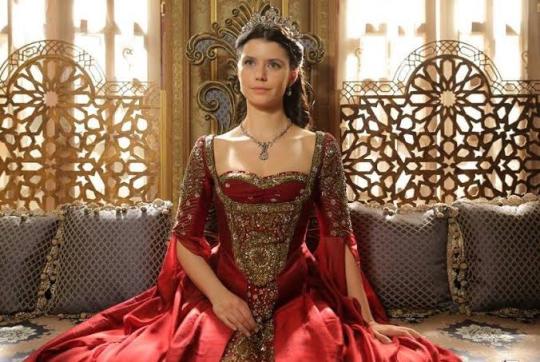
To be continued
Coming up next - Kosem Sultan: Rise to Power Episode 2
8 notes
·
View notes
Photo
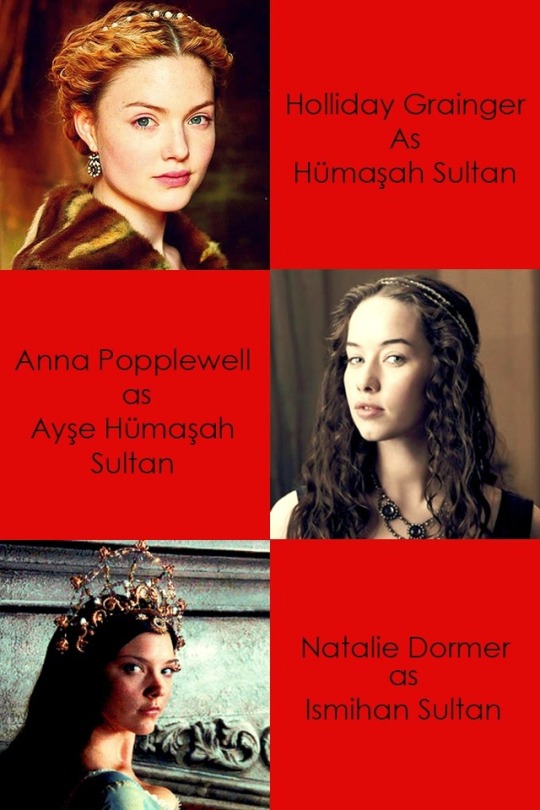

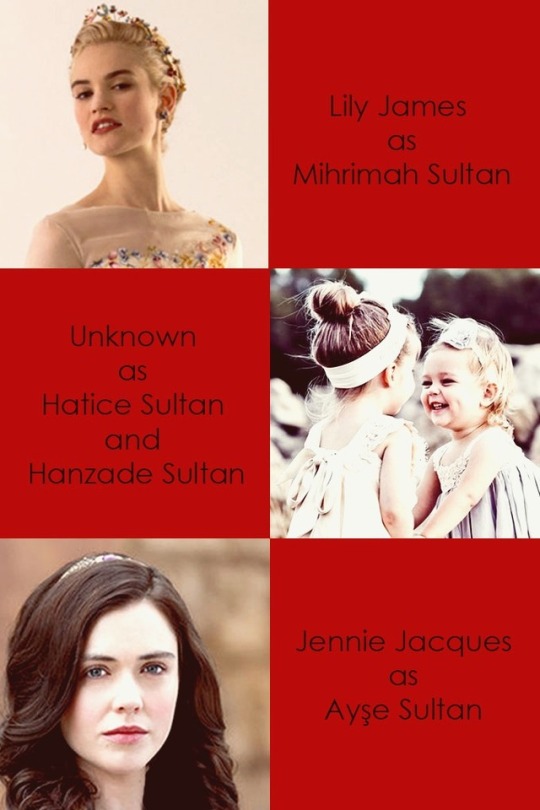
Muhteşem Yüzyıl (Magnificent Century) fancast: Daughters of Hürrem Haseki Sultan. Second generation.
1. Hümaşah Sultan (1540-1593) - daughter of Şehzade Mehmed of the Ottoman Empire.Like her cousin Ayşe Hümaşah Sultan, she was reportedly beloved by their grandfather, to whom she wrote letters.She is regarded amongst the most influential women of Suleiman's reign.This affection can be explained, in large measure, by the fact that her late father, Mehmed, was Suleiman's favorite son. It was she who, in 1563, gifted her cousin Şehzade Murad (future Sultan Murad III) with a concubine that would go on to be Safiye Sultan.
2. Ayşe Hümaşah Sultan (1541–1594) - daughter of Mihrimah Sultan of the Ottoman Empire and Rüstem Pasha. She was her parents' first child and only daughter, and possibly her grandparents' first grandchild as well. She had several brothers, whose number and names are though contested.
3. Ismihan Sultan (1544 – 1585) - daughter of Selim II and Nurbanu Sultan. She was the most powerful daughter of Selim II because she was married to the Grand Vizier Sokollu Mehmed Pasha. She is famous for having built the Sokollu Mehmed Pasha Mosque and Esmahan Sultan Mosque.
4. Gevherhan Sultan (1544 - after 1604) - daughter of Sultan Selim II and Nurbanu Sultan. Soon after his succession, Mehmed's son by Handan Sultan, Ahmed I wanted to express his gratitude to Mehmed Pasha and Gevherhan Sultan for the role they had played in bringing his parents together. He also named one of his daughters after her.
5. Şah Sultan (1545 – 1580) - daughter of Selim II and Nurbanu Sultan. The union of Şah Sultan to Zal Mahmud is said to be a very happy one. They were suited to each another. It was said that, that they fell ill at the same time, lay in their deathbeds together, and expired at the same very moment.
6. Fatma Sultan (1559–1580) - daughter of Sultan Selim II. Fatma was born in 1559,during Selim's princedom, at Konya or Karaman where he served as sanjakbey, or provincial governor, at the time.
7. Mihrimah Sultan (1547 – 1594) - daughter of Şehzade Bayezid. Married in 1562 to Damat Müzaffer Pasha.
8. Hatice Sultan and Hanzade Sultan (1550/1556-?) - daughters of Şehzade Bayezid.
9. Ayşe Sultan (1553- 1572) - daughter of Şehzade Bayezid. Married in 1562 to Damat Hoca Ali Pasha Eretnaoğlu.
#hurrem sultan#magnificent century#muhteşem yüzyıl#Mihrimah Sultan#nurbanu sultan#sultan suleyman#perioddramaedit
35 notes
·
View notes
Text
reallifesultanas Thank you very much for your answer! Yes I meant Dumas not Alderson sorry for that! Is there a reason for the illogical amount of salaries? I mean the earlier salary lists of registers clearly help us to indentify the sultanas. The 1555-1556 registers are 100% logical; the 1603-1604 registers are still logical: Safiye, Handan, aunts of Ahmed, great-aunt of Ahmed, great-great aunt's daughter (Ayse Hümasah), cousin of Mehmed III, far relatives. But then there is this one.. highest salary for the full sisters of the sultan is logical, but then what does the daughters of Murad III doing there? Fahri/Kamer and Hümaşah/Rukiye* are surely Murads and so Ümmügülsüm could be also Murad's... For the lesser salaries Beyhan, Safiye, Hatice I could imagine they were Mehmed III's, maybe Beyhan's Mustafa was Mirahur Mustafa? But these stipends are just not logical... (*Murad III's daughte Rukiye was said to be married to Nakkas Hasan not Huma). And for Ümmügülsüm there is that one report from 1688 (Katherine Trumbull) when it is said she developed a relationship with Sultana Ümmühan, the aunt of the deposed Sultan Mehmed IV, through visits to the harem. This Ümmühan could be Halil Pasha's wife and so Murad III's/Mehmed III's daugher, or is it more likely not an aunt but sister/cousin? Or she truly can be Ahmed I's daughter? There is this 85 numaralı Mühimme defteri that provide some informations suggesting suggesting Ümmügülsüm was sister of Murad IV. Sadly I dont have the book so I cannot check how true is this claim...
I hope you don't mind if we continue here on ottomanladies.
I know the harem register doesn’t seem to make sense from the point of view of hierarchy but we must remember that the hierarchy could be broken on the basis of favouritism. Maybe those aunts were more favoured than the others.

In this table we can see Gevherhan Sultan, a great-aunt of Ahmed I’s, the reigning sultan. Dumas mistakenly identifies her as a daughter of Murad III’s and a concubine of non-haseki rank, but the reality is she’s first because she’s the most senior princess alive. If you look closely at the second category — “Frais de bouche” — she receives the same amount as Ayse and Fatma, Safiye’s daughters. Gevherhan was quite favoured by Ahmed I because she had trained Handan in her household. Also, her late husband Cerrah Mehmed Pasha had performed Ahmed I’s circumcision. Borekçi says that she was the only recipient — apart from Handan and Safiye — of sable fur:
“A register preserved in the Topkapı Palace Archives gives further details of the gifts Gevherhan Sultan received from her great grand-cousin. At the beginning of this register, there are records of the furs and robes of honor sent by the new sultan to his larger family right after his enthronement on December 27, 1603. Here, Gevherhan Sultan is listed as a recipient of a sable robe (semmûr kaplu nimtâne) and recorded as the third female member of the dynasty after the retiring queen mother, Safiye Sultan, and the new queen mother, Handan Sultan, and before all other living sisters and daughters of Murad III and Mehmed III -- a clear indication of her privileged position. Later, on February 6, 1604, she again appears in the register, this time as the only female family member apart from Handan Sultan to receive a fur-trimmed silk robe.”
(I believe the 6 şehzâdegân are unmarried princesses that Ahmed still had to matchmake but this is another story)
I know it’s Rukiye that Öztuna says has married Nakkaş Hasan Pasha but he could be wrong tbh, it wouldn’t be the first time. Also, neither Sakaoğlu or Uluçay confirm this; they give no information about Rukiye except for the identity of her mother. Unfortunately Öztuna never gives his sources so we don’t know where he found that Rukiye was married to Nakkaş Hasan Pasha. I would trust the harem register and contemporary sources (the ragusian diplomat, in this case) more tbh… both say that Nakkaş Hasan Pasha was married to a princess called Hümaşah…
About Beyhan… the problem is the wife of Mirahur Mustafa Pasha went on to marry Cigalazade Sinan Pasha’s son Mahmud Bey in 1612, and died before 1620, the date of Mahmud Bey’s second wedding, which means she shouldn’t have been alive in 1638-39. The Ragusian letter date 1648, though, lists a Beyhan Sultan widow of “Nideli Mustafa Pasha”— unfortunately, I can’t say who this man is or what “nideli” means.
I do agree with you, though. I think that Beyhan, Safiye, and Hatice are daughters of Mehmed III. We know that seven princesses were married in the summer of 1613, after all. A letter dated July 1613 by a Ragusian diplomat, furthermore, says that “at the present there are fifteen sultanas”.
About Katherine Trumbull, I guess you mean this:
“While in Istanbul, Katherine had developed a relationship with Sultana Ümmühan, Mehmed IV’s aunt and sister to Ibrahim II. On 14 July 1688, Katherine met with Ümmühan for the first time, and the two women continued to meet in the imperial harem throughout Trumbull’s residence in Istanbul. During these visits, Katherine must have been accompanied by someone with knowledge of spoken Turkish, or else it is unclear how she would have been able to communicate with the women she met in the harem. At any rate, when she returned to the embassy, she brought to Trumbull news of things taking place in the Ottoman court.” — Ghobrial, John-Paul A, 'Overcoming Distance in Everyday Communication', The Whispers of Cities: Information Flows in Istanbul, London, and Paris in the Age of William Trumbull (Oxford, 2013; online edn, Oxford Academic, 23 Jan. 2014)
Unfortunately, William Trumbull’s diaries were not published, they’re in the British Library. I always like to cross-check my sources and the fact that I can’t read the original kind of annoys me. Ümmühan is quite an unusual name for an Ottoman princess: Ümmi means mother and Han sovereign, it kind of sounds like “valide sultan”, which is why I thought it was a title for a moment but I couldn’t find anything to confirm this. It is kind of interesting, though, that Öztuna says that Ibrahim’s eldest daughter was called Ümmügülsüm, who could have been named after another Ümmügülsüm (the one that in 1622 was unmarried? Who knows)
The Mühimme defteri is not a book but a collection of copies of all the imperial decrees or decisions taken in the imperial council. They’re numbered and the number 85 refers to the years 1630-31. You can find the PDF for free on the website of the Turkish National Archives but, well, it’s in Ottoman Turkish.

(This is one of them)
So I can’t really read it even though I have it.
#ask: ottoman history#reallifesultanas#gevherhan sultan daughter of selim ii#rukiye sultan daughter of murad iii#humasah sultan daughter of murad iii#unnamed daughters of mehmed iii#i'm sorry if the layout looks weird but it's been so long since i used tumblr and i'm a little rusty
11 notes
·
View notes
Photo










Ahmed III of the Ottoman Empire + daughters who reached adulthood
#history#historyedit#ottoman history#ahmed iii#fatma sultan daughter of ahmed iii#ummugulsum sultan daughter of ahmed iii#atike sultan daughter of ahmed iii#zeynep sultan daughter of ahmed iii#saliha sultan daughter of ahmed iii#ayse sultan daughter of ahmed iii#hatice sultan daughter of ahmed iii#nefize sultan daughter of ahmed iii#esma sultan daughter of ahmed iii#zubeyde sultan daughter of ahmed iii#ottomanladiesedit#daughtersof
350 notes
·
View notes
Photo







Ottoman Princesses named: Hatice
Hatice is the Turkish equivalent of the Arabic name Khadija, the name of the first wife of Prophet Muhammad. As such, it was one of the most popular names in the Ottoman Dynasty both for princesses and consorts.
#history#historyedit#ottoman history#hatice hatun daughter of orhan#hatice hatun daughter of murad ii#hatice sultan daughter of mehmed iii#hatice sultan daughter of mehmed iv#hatice sultan daughter of mustafa iii#hatice sultan daughter of mahmud ii#hatice sultan daughter of murad v#durrusehvar sultan daughter of abdulmecid ii#ottomanladiesedit#princessesnames#hatice hatun daughter of mehmed i#hatice sultan daughter of bayezid ii#hatice sultan daughter of sehzade bayezid#hatice sultan daughter of ahmed iii#hatice sukriye sultan daughter of sehzade yusuf izzeddin#long post
1K notes
·
View notes
Text
On this day, 27 September, in Ottoman history:
27 September 1710 - birth of Hatice Sultan: daughter of Ahmed III and his Second Imperial Consort, Rukiye Kadın, she married Ahmed Paşa in 1724. Three fountains in Istanbul bear her name; among these is the Hatice Sultan Fountain in Üsküdar which her father Ahmed III had built in her honour. She died in 1738, at the age of 28, and was buried in the New Mosque. Later, her mother would be buried next to her.
#history#ottoman history#on this day in history#on this day in ottoman history#hatice sultan daughter of ahmed iii#rukiye kadin
13 notes
·
View notes
Text
On this day, 27 February, in Ottoman history
27 February 1656 - execution of Meleki Hatun; accused of taking bribes, of governing in the sultan’s place and of being generally corrupted, she was taken from her house and executed by rebelling soldiers. She reportedly dressed magnificently, richer than the Sultan himself, and Mehmed IV would call her “aunt” in front of his statesmen. She would also change the sultan’s written orders at her pleasure. Eremya Çelebi blamed her for the assassination of Kösem Sultan, saying she switched alliance to Turhan Sultan and together they had the Great Valide Sultan killed with an excuse. After Meleki Hatun’s execution, Mehmed apparently said “I pray to God that my mother will forgive me.”
27 February 1714 - wedding of Hatice Sultan; daughter of Ahmed III and Rukiye Kadın, his Second Consort. The celebrations of her wedding to Hafız Ahmed Paşa started on 27 February 1714.
#history#on this day in history#on this day in ottoman history#hatice sultan daughter of ahmed iii#kosem sultan#turhan hatice sultan#meleki kalfa
31 notes
·
View notes
Text
On this day, 25 February, in Ottoman history
25 February 1495 - death of Sultan Cem; son of Mehmed II and Çiçek Hatun, he fought for the throne against Bayezid II after the Conqueror’s death. Ultimately defeated, he firstly sought refuge in Rhode, then he was transferred to the Pope’s care who, in the end, was compelled to release him to the French King Charles VIII, who had invaded Italy. In January 1495, confident of the threat Cem represented to Bayezid II, Charles VIII announced a new crusade against the Turks. Cem, though, became sick and eventually died in Capua, near Naples. Some say he was poisoned but there is no evidence to this.
25 February 1643 - birth of Ahmed II; son of Sultan Ibrahim and Haseki Hatice Muazzez Sultan, he was the sultan’s third-born son. He would eventually succeed his older brother Suleyman II, but reigned only for 3 years and 7 months, which he spent in Edirne.
25 February 1656 - execution of other favourites of Turhan Hatice Sultan; after the executions of the Chief Black Eunuch and the Chief White Eunuch, the people, dissatisfied, marched again to the palace and asked to see the sultan. That day the Treasurer Yusuf Ağa and Turhan Hatice Sultan’s eunuch İbrahim Ağa were executed.
25 February 1724 - entrance of Ahmed Paşa in Istanbul; son of Çerkes Osman Paşa, he was selected as damad and husband for Hatice Sultan, daughter of Ahmed III. On February 25th he arrived in Istanbul and was hosted by Nevşehirli İbrahim Paşa and later attended a banquet given by his future wife.
25 February 1850 - death of Mukbile Sultan; daughter of Abdülmecid and his Fourth Ikbal, she was born on February 9th of the same year. She was buried in the Havatin Türbe.
#history#on this day in history#on this day in ottoman history#ahmed ii#turhan hatice sultan#hatice sultan daughter of ahmed iii
17 notes
·
View notes
Text
On this day, 21 February, in Ottoman history
21 February 1724 - engagement ceremonies of Ümmügülsüm Sultan, Hatice Sultan and Atike Sultan, daughters of Ahmed III; the Şeyhülislam Abdullah Efendi first went to Ali Paşa, Ümmügülsüm Sultan‘s fiancé; then to Ahmed Paşa and Hatice Sultan and lastly, to Mehmed Paşa and Atike Sultan. Banquets were organised at noon and two times a day for ten days due to the multitude of guests; Ali Paşa and the other grooms also gave banquets.
21 February 1769 - death of Mihrişah Sultan; daughter of Mustafa III and an unknown concubine, she was born on 11 December 1762. She was buried in Laleli Mosque.
21 February 1890 - birth of Gülnev Hanım; one of the consorts of Şehzade Ömer Hilmi, third son of Mehmed V. She had entered the prince’s harem by October 1910. She had two children with him: Şehzade Mahmud Namık and Emine Mükbile Sultan. She was awarded the Order of Charity - first class by Mehmed V.
21 February 1936 - death of Elaru Mevhibe Kadın; Murad V’s Senior Consort (Baş Kadın) even though she had no children. She was very beautiful and her face warmed with pink whenever she talked. She was highly intelligence and perceptive. She remained loyal to Murad V throughout her life, staying in Çırağan Palace until his death. Afterwards, she purchased a house in Şişli, and lived a life of seclusion, not even going out, until she died at 101.
#history#on this day in history#on this day in ottoman history#ummugulsum sultan daughter of ahmed iii#hatice sultan daughter of ahmed iii#atike sultan daughter of ahmed iii#gulnev hanim#elaru mevhibe kadin
17 notes
·
View notes
Photo






The granddaughters of Sultan Ahmed III of the Ottoman empire who reached adulthood -- requested by anon
#history#historyedit#ottoman history#ahmed iii#saliha sultan daughter of ahmed iii#ayse sultan daughter of ahmed iii#esma sultan daughter of ahmed iii#sah sultan daughter of mustafa iii#beyhan sultan daughter of mustafa iii#hatice sultan daughter of mustafa iii#ayse durrusehvar hanim daughter of abdulhamid i#esma sultan daughter of abdulhamid i#hibetullah sultan daughter of abdulhamid i#ottomanladiesedit
118 notes
·
View notes
Photo






𝐢𝐧 𝐭𝐡𝐞 𝐦𝐨𝐧𝐭𝐡 𝐨𝐟 𝐌𝐚𝐫𝐜𝐡 𝐢𝐧 𝐎𝐭𝐭𝐨𝐦𝐚𝐧 𝐡𝐢𝐬𝐭𝐨𝐫𝐲
#history#historyedit#ottoman history#ottomanladiesedit#*everymonth#reftaridil kadin#beyhan sultan daughter of ibrahim i#hibetullah sultan daughter of abdulhamid i#sehzade mehmed son of ahmed i#bayezid i#hatice sultan daughter of murad v#esma sultan daughter of ahmed iii#pargali ibrahim pasa#durrinev kadin#sayan kadin#sehzade abdulkadir son of abdulhamid ii#naime sultan daughter of abdulhamid ii#osman ii#akile hatun#abdulhamid i#saliha sultan daughter of ahmed iii#esma sultan daughter of abdulaziz#zeynep sultan daughter of ahmed iii#zubeyde sultan daughter of ahmed iii#resan hanim#mehmed ii
136 notes
·
View notes
Photo

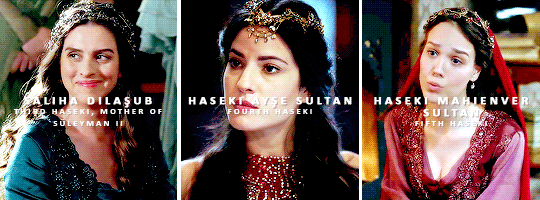

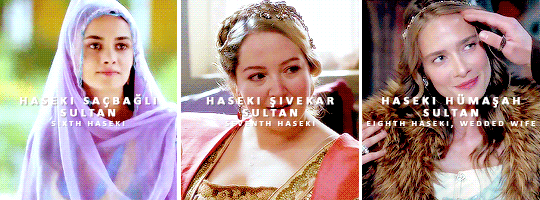

Ibrahim Han of the Ottoman Empire + the women in his life
#history#historyedit#ottoman history#kosem sultan#turhan hatice sultan#haseki hatice muazzez sultan#saliha dilasub sultan#haseki ayse sultan iii#haseki mahienver sultan#haseki sacbagli sultan#haseki sivekar sultan#haseki humasah sultan#sekerpare hatun#ayse sultan daughter of ahmed i#fatma sultan daughter of ahmed i#hanzade sultan daughter of ahmed i#kaya ismihan sultan daughter of murad iv#ottomanladiesedit#*womeninlife
388 notes
·
View notes